Are there alternate tunings for the 8-Note Kalimba?
The obvious place to start with your 8-Note kalimba is the C major scale. If your kalimba is larger than typical, it will resonate at lower notes, and could be tuned to another major scale, such as Bb major, G major or even E major. Even if your kalimba is a small one that doesn’t want to be tuned down to F, you can still tune to F very simply, by changing the B tine to a Bb. It will still be the notes of a major scale, but the kalimba still starts on C, the 5th in the key of F. And then there are the crazy tunings you can get by abandoning the western major scale as a starting point.
Again, the entire point to these alternative scales is that they will each play different musics. The 8-Note Kalimba can be tuned to different scales from around the world.
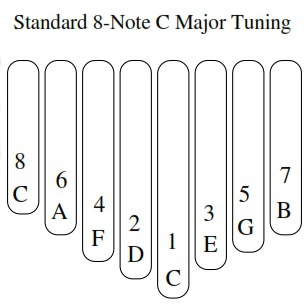
Most 8-Note Kalimbas have a standard tuning of the C major scale (the Goshen Box 8-Note Kalimba has the same basic note layout but is tuned to D major instead). Most 8-Note Kalimba books assume you have this tuning. While this tuning is totally logical, there are actually a lot of other tunings that you can do wonderful things with.
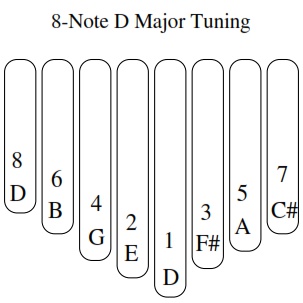
The Goshen 8-Note Box Kalimba has the same basic tuning, except every note is a whole step higher, putting it in D major. You can still use the same 8-Note books, but if you listen to the sound recordings, you cannot play along as it is in a different key. If you have a kalimba in C and want this tuning, you will have to push every tine in a whole step… a significant retuning adventure. (That is, experiment with an easier retuning before you take on something like this.)
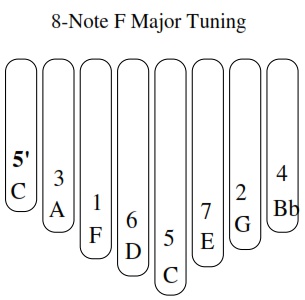
If you compare this tuning chart to the C major tuning, you will notice that the letters are all the same, except that B has turned into Bb (B flat) – that is, you pull it out slightly to make it a bit longer and lower. This action will change it from being the7th of the scale and make it be the 4th… counting down, F is now the root, and the low note (and the top note) on this kalimba, C, is now the 5th.
Why would you want to do this? It turns out that there are a whole bunch of songs you can play on an 8-note kalimba set up like this, and they are not possible in the standard setup. And the best news? This is the smallest possible retuning you can do, and you get a huge result from it! We have a 32 Song download for the 8-Note in this tuning; click the link to purchase the download.
There is a great songbook for this 8-Note F Tuning.
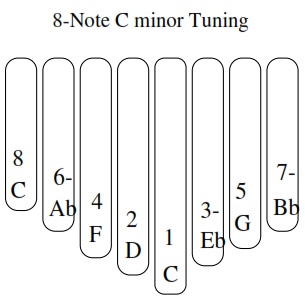
After you pull out your B tine to make it a Bb, you might also consider pulling out the A tine and E tine to Ab and Eb. Why would you do this? These changes will give you a minor 3rd, a minor 6th, and a minor 7th – all the changes you need to accomplish to form the C natural minor tuning. This tuning will be more melancholy, more moody, more mystical. In other words, it will play totally different music, and it is still a very simple retuning, and it is easy to go back to the standard C major. Try it, I think you’ll like it.
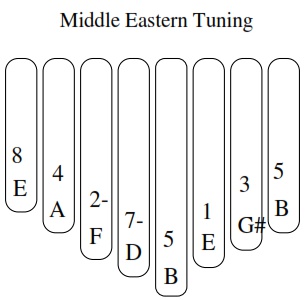
By now you are getting the idea: small changes in the notes you have on your kalimba can make profound changes in the music that comes out of it. The important change in this Middle Eastern tuning is the G going to a G#. Tuning the low C down to a B, and the high C up to an E, are less important changes that serve to reinforce the E as the new root. This tuning will play very cool Middle Eastern sounding music. And there is a very nice repertoire of music for the 17-Note Kalimba tuned to the same Middle Eastern scale. In other words, try this on your 8-Note Kalimba, and if you like it, you might want to play a 17-Note Kalimba in the same scale.
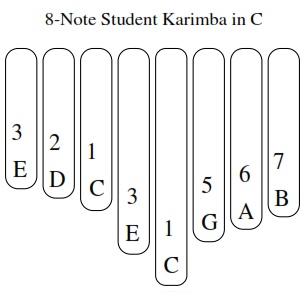
This is perhaps the most important alternative tuning – it reproduces the African Tuned Karimba, also called the Student Karimba. It is thought to be the original tuning of the African Mbira over 1000 years ago, and is thought to be the tuning that Father Do Santos saw when he first wrote about the kalimba in 1586 in present-day Mozambique. Also, you can find a lot of instructional material on this tuning in the Student Karimba section by clicking below. This student karimba tuning can be made in any key – A, G, and F are good examples, as the A can play with the Hugh Tracey African Tuned Karimba, the G can play with the Hugh Tracey Alto and Treble Kalimbas, and the F can play with the Kwomangoma Karimba.
Learn about the Student Karimba
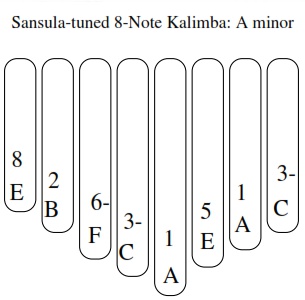
The Sansula is one of the coolest kalimbas in the world, and costs a lot of money too – but the good news is that you can put the 9-Note Sansula tuning on your inexpensive 8-Note Kalimba. How can you get a 9-note tuning onto an 8-note kalimba? Because the Sansula’s standard tuning has two tines tuned to the same high A note, and this one doesn’t. This tuning is an A minor derived from the Ake Bono scale. Learn more about the Sansula by clicking below. Read more
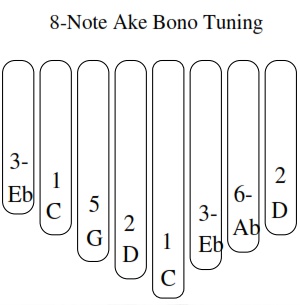
The Sansula tuning is based on the Japanese Ake Bono scale, but it skips a note. Here we have reproduced the C minor Ake Bono scale, without skipping any notes. This is a great scale, and playing it can transport you to another continent and time.
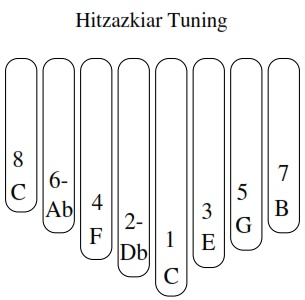
The Hitzazkiar tuning is a Persian scale similar to the Middle Eastern tuning. Look at the right side – C E G B – these are the same notes as the standard tuning, but the notes on the left side are all one half-step above the notes on the right side.


Sign up for our newsletter and free resources with your email address:
We pinky promise not to spam you and to only send good stuff.
 Christmas in July 2025
Christmas in July 2025 Patriotic and American Music for Kalimba
Patriotic and American Music for Kalimba